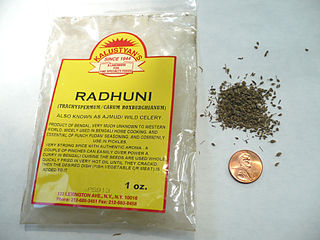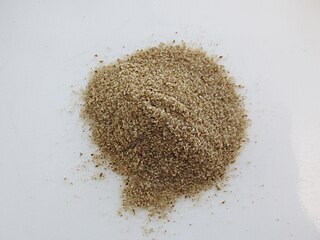
Celery is a marshland plant in the family Apiaceae that has been cultivated as a vegetable since antiquity. Celery has a long fibrous stalk tapering into leaves. Depending on location and cultivar, either its stalks, leaves or hypocotyl are eaten and used in cooking. Celery seed is also used as a spice and its extracts have been used in herbal medicine.

Septoria are ascomycete pycnidia-producing fungi that causes numerous leaf spot diseases on field crops, forages and many vegetables including tomatoes which are known to contract Septoria musiva from nearby cottonwood trees, and is responsible for yield losses. The genus is widespread, and estimated to contain 1072 species. Pycnidia produce needle-like pycnidiospores.

Celeriac, also called celery root, knob celery, and turnip-rooted celery, is a variety of celery cultivated for its edible stem or hypocotyl, and shoots. Celeriac is like a root vegetable except it has a bulbous hypocotyl with many small roots attached.
Cel-Ray is a celery-flavored soft drink from Dr Brown's. It is fairly easy to find in New York City, Philadelphia, Baltimore, and in South Florida, but rather obscure elsewhere.

Trachyspermum roxburghianum is a flowering plant in the family Apiaceae. It is grown extensively in South Asia, Southeast Asia, and Indonesia. Its aromatic dried fruits, like those of its close relative ajwain, are often used in Bengali cuisine but are rarely used in the rest of India. The fresh leaves are used as an herb in Thailand and it is used medicinally in Myanmar and Sri Lanka.

Celery salt is a seasoned salt used as a food seasoning, made from ground seeds, which may come from celery or its relative lovage. It is also sometimes produced using dried celery or seed oleoresin.

Apigenin (4′,5,7-trihydroxyflavone), found in many plants, is a natural product belonging to the flavone class that is the aglycone of several naturally occurring glycosides. It is a yellow crystalline solid that has been used to dye wool.

Bouteloua dactyloides, commonly known as buffalograss or buffalo grass, is a North American prairie grass native to Canada, Mexico, and the United States. It is a shortgrass found mainly on the High Plains and is co-dominant with blue grama over most of the shortgrass prairie.

Cercospora is a genus of ascomycete fungi. Most species have no known sexual stage, and when the sexual stage is identified, it is in the genus Mycosphaerella. Most species of this genus cause plant diseases, and form leaf spots. It is a relatively well-studied genus of fungus, but there are countless species not yet described, and there is still much to learn about the best-known of the species.

Timothy Duncan Groenewald is an English-South African professional cricketer. He is a right-handed batsman and a right-arm medium-fast bowler who signed for Kent County Cricket Club, an English cricket club, at the end of the 2019 season, having previously played for Somerset. He was born in Pietermaritzburg, South Africa but holds a British passport through his mother and therefore plays as a domestic player in county cricket.

Cercospora beticola is a fungal plant pathogen which typically infects plants of the genus Beta, within the family of Chenopodiaceae. It is the cause of Cercospora leaf spot disease in sugar beets, spinach and swiss chard. Of these hosts, Cercospora leaf spot is the most economically impactful in sugar beets. Cercospora beticola is a deuteromycete fungus that reproduces using conidia. There is no teleomorph stage. C. beticola is a necrotrophic fungus that uses phytotoxins specifically Cercospora beticola toxin (CBT) to kill infected plants. CBT causes the leaf spot symptom and prevents root formation. Yield losses from Cercospora leaf spot are around 20 percent.
Cercospora kikuchii is a fungal plant pathogen that affects soybeans. It results in both the Cercospora leaf blight and purple seed stain diseases on soybean and is found almost worldwide. C. kikuchii produces the toxin cercosporin, as do a number of other Cercospora species.

Cercospora apii is a fungal plant pathogen, who causes leaf spot on celery, and found on other plants, including Impatiens. Since the genus Cercospora is one of the largest and most heterogeneous genera of hyphomycetes, numerous species described from diverse hosts and locations are morphologically indistinguishable from C. apii and subsequently are referred to as C. apii sensu lato.

The Mycosphaerellaceae are a family of sac fungi. They affect many common plants, such as eucalyptus, the myrtle family, and the Proteaceae. They have a widespread distribution.

The Loch Lomond Vernal Pool Ecological Reserve is a nature reserve of 8.22 acres (33,300 m2) in the community of Loch Lomond in Lake County, California. It is one of 119 ecological reserves managed by the California Department of Fish and Game (CDFG). The ecological reserve system was authorized by the state legislature in 1968 for the purpose of conservation and protection of rare plants, animals and habitats.

Grey leaf spot (GLS) is a foliar fungal disease that affects maize, also known as corn. GLS is considered one of the most significant yield-limiting diseases of corn worldwide. There are two fungal pathogens that cause GLS: Cercospora zeae-maydis and Cercospora zeina. Symptoms seen on corn include leaf lesions, discoloration (chlorosis), and foliar blight. Distinct symptoms of GLS are rectangular, brown to gray necrotic lesions that run parallel to the leaf, spanning the spaces between the secondary leaf veins. The fungus survives in the debris of topsoil and infects healthy crop via asexual spores called conidia. Environmental conditions that best suit infection and growth include moist, humid, and warm climates. Poor airflow, low sunlight, overcrowding, improper soil nutrient and irrigation management, and poor soil drainage can all contribute to the propagation of the disease. Management techniques include crop resistance, crop rotation, residue management, use of fungicides, and weed control. The purpose of disease management is to prevent the amount of secondary disease cycles as well as to protect leaf area from damage prior to grain formation. Corn grey leaf spot is an important disease of corn production in the United States, economically significant throughout the Midwest and Mid-Atlantic regions. However, it is also prevalent in Africa, Central America, China, Europe, India, Mexico, the Philippines, northern South America, and Southeast Asia. The teleomorph of Cercospora zeae-maydis is assumed to be Mycosphaerella sp.
Stenella uniformis, formerly Cercospora capparidicola is a species of anamorphic fungi.
Celery powder is a dried, ground concentrate prepared from fresh celery that is used as a seasoning and as a food preservative in organic meat products. Several commercial preparations exist, and it can also be made using a food dehydrator. Some celery powders are prepared from celery juice.

Petrus Johannes "Pieter" Groenewald is a South African politician. He has been serving as the Leader of the Freedom Front Plus since his election in November 2016. He started his political career by being elected Mayor of Stilfontein in 1988. He relinquished the position in 1989 due to his election to the House of Assembly. Groenewald co-founded the Freedom Front in 1994, and served as a Member of the National Assembly until his election to the North West Provincial Legislature in 1999. He returned to the National Assembly in 2001.
Ignatius Michael "Michal" Groenewald is a South African politician serving as a Member of the National Assembly of South Africa. A member of the Freedom Front Plus (FF+), he is the party's provincial leader in the North West. Groenewald serves alongside his father and party leader, Pieter Groenewald, in Parliament. He was previously a municipal councillor in the Matlosana Local Municipality.














